Impact of Dubai's Red Line Metro Stations on Urban Growth
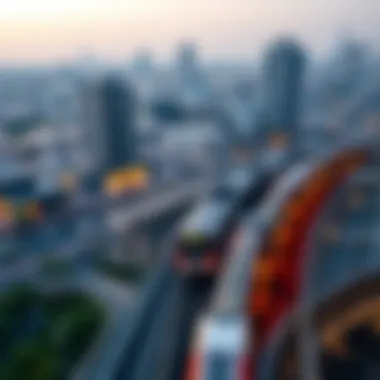
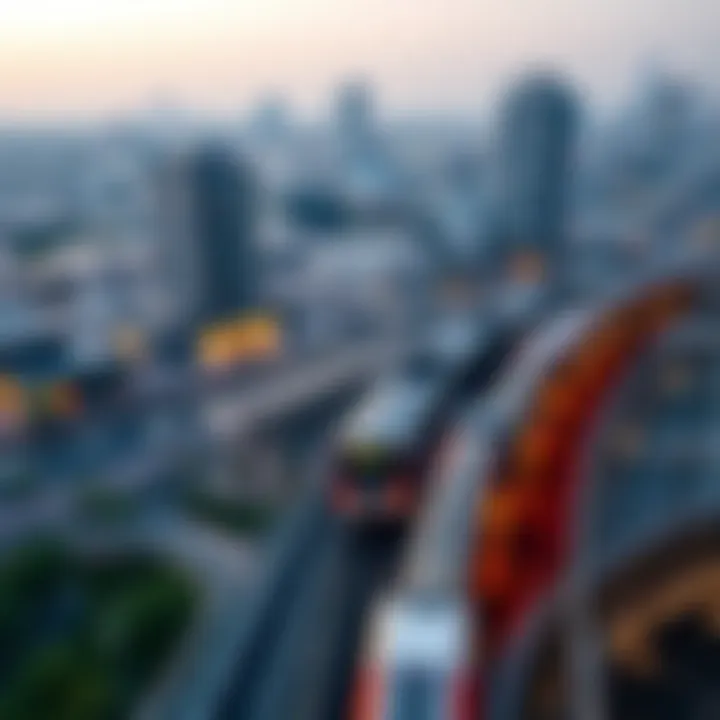
Intro
The Red Line of Dubai Metro undoubtedly stands as a cornerstone of the Emirate's transport infrastructure, intertwining the pulse of the city with its vast landscape of opportunities. As we embark on this exploration, one can discern how these metro stations not only ease the daily grind of commuters but also play a significant role in shaping real estate dynamics and urban planning.
With each station offering unique characteristics and connectivity, they significantly affect demographic patterns and, by extension, property values. This analysis sharpens the focus on their implications for investors, homebuyers, and urban developers who are keen to ride the wave of urban growth and appreciate their chances in Dubai’s evolving property market.
Therefore, understanding the nuances of the Red Line metro stations is more than just a journey on rails; it’s an exploration of aspirations, lifestyles, and investments in one of the most rapidly changing urban landscapes in the world. Let's delve into the current market trends that reveal the landscape of property prices and future forecasts.
Market Trends
Current Property Prices
In recent years, the real estate market has seen significant fluctuations, reflected in the property prices near various metro stations along the Red Line. These stations often serve as magnets for residential and commercial development due to their accessibility. Areas such as Burj Khalifa/Dubai Mall, Business Bay, and Jumeirah Lakes Towers demonstrate a higher average property price per square meter compared to their counterparts further from the stations.
As of mid-2023, prices in these key areas hover around AED 1,800 to AED 2,500 per square meter, demonstrating an upward trend as demand continues to outstrip supply. Intriguingly, the proximity to the metro stations is often a significant factor contributing to market value.
- Burj Khalifa/Dubai Mall: AED 2,300 - AED 2,500
- Business Bay: AED 1,900 - AED 2,300
- Jumeirah Lakes Towers: AED 1,800 - AED 2,000
This string of price elevation isn’t just a value climb; it’s a reflection of lifestyle choices that many young expatriates and professionals gravitate towards, hoping to balance convenience against the backdrop of Dubai’s bustling business scene.
Future Forecasts
Looking ahead, some analysts suggest that property values near these stations will continue the upward trajectory. With the completion of new developments and planned urban expansion, there’s optimism in the market. Key infrastructure projects, such as the extension of the metro line to new hotels and entertainment hubs, are likely to further bolster surrounding real estate prices.
Several sources forecast a potential growth of 5% to 10% in property values near the Red Line over the next five years. Developers are keenly aware of this trend and are targeting opportunities around these stations to capitalize on future growth. The projections align with the city’s ambition to diversify its economy and further solidify its status as a business and tourism hub.
Prelims to the Red Line
The Red Line, spanning across the heart of Dubai, serves as a pivotal component of the city’s public transportation system. It's not just a mode of travel; it symbolizes the rapid urbanization and transformative growth that Dubai has experienced over the past few decades. This section will explore various facets of the Red Line, highlighting its significance in shaping both daily commutes and the broader urban environment.
Historical Background
The inception of the Red Line can be traced back to the early 2000s when Dubai was poised to open its doors to the world, aiming to enhance economic development and tourism. Groundbreaking ceremonies kicked off construction in 2006, culminating in the inauguration of the line in September 2009.
Interestingly, the line originally depicted a mere vision of modernity, emphasizing the push for a sustainable and efficient transport solution. To reflect on its historical evolution, it’s crucial to acknowledge that the Red Line was the first metro line in Dubai and set the foundation for future expansions and developments in the public transport sector. The infrastructure alone has witnessed a blend of traditional Arabian culture interlaced with cutting-edge technology, providing riders an experience that is both cultural and futuristic.
Strategic Importance in Dubai's Transport Network
Understanding the strategic importance of the Red Line is key to grasping how it ties into the larger tapestry of Dubai's transport network. It acts as a vital artery, connecting various districts and key landmarks, enhancing the overall accessibility of the city. This connectivity is pivotal for residents, expatriates, and tourists alike, playing a vital role in reducing traffic congestion and promoting an eco-friendly approach to urban mobility.
Moreover, the stations along the Red Line are strategically located near major commercial hubs, schools, and residential areas. For instance, stations like Burj Khalifa, which is not only an iconic structure but also a major tourist attraction, enable easy access for thousands of visitors every day.
In addition to improving mobility, the line supports economic growth by fostering an environment conducive to business development, real estate investments, and job creation. In essence, the Red Line is more than just a transportation facet; it’s a driving force behind Dubai’s aspirations to cultivate a global, smart city, where innovation and transport resonate in harmony.
"The metro not only eases the flow of people but also showcases Dubai's journey towards a sustainable future."
Through these critical lenses of history and strategy, we begin to appreciate the intricate role the Red Line plays not just in transport but in the urban fabric of Dubai. Investors, urban planners, and anyone interested in the evolution of modern cities will find a wealth of insights as we continue to explore the nuances of each metro station on the Red Line.
Metro Stations Overview
The importance of metro stations within the context of the Red Line extends beyond mere transportation links. They serve as vital nodes in the urban fabric of Dubai, supporting not just mobility but also socio-economic development. Investing in property near these stations can yield promising returns, given the evolving demands of urban living and commuting patterns. Understanding the benefits and considerations surrounding these metro stations is key for potential investors, homebuyers, and urban planners alike.
List of Stations on the Red Line
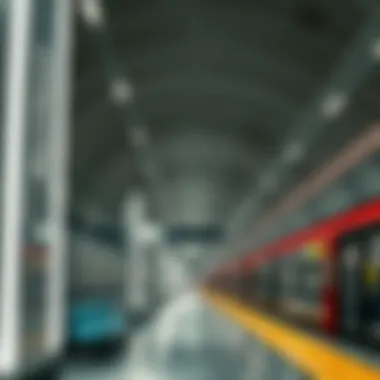
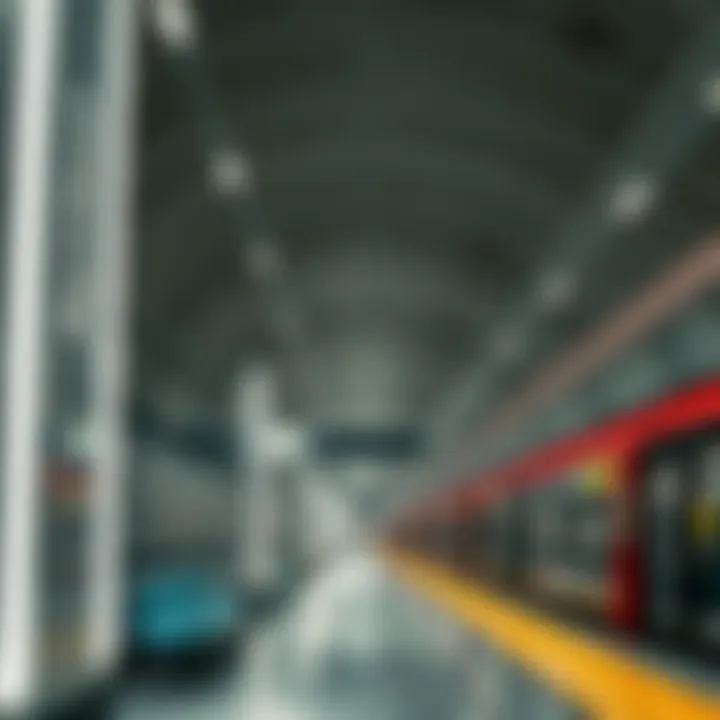
The Red Line is home to 29 operational metro stations, each distinct yet contributing to an integrated transportation system. The journey starts at Rashidiya and culminates at UAE Exchange. Notable stations include:
- Rashidiya: A bustling gateway to residential neighborhoods, setting the stage for the journey.
- Deira City Centre: This station connects shoppers and business travelers to one of the city's major malls, enhancing commercial activity.
- Burj Khalifa/Dubai Mall: Situated near the world’s tallest building, this station sees hefty foot traffic, particularly from tourists.
- Dubai Marina: Known for its waterfront lifestyle, this station facilitates access to leisure and recreation, boosting nearby property values.
- UAE Exchange: Ending the line, it serves as a crucial terminal for commuters traveling to Abu Dhabi and beyond.
In addition, frequent stops like Jumeirah Lakes Towers and Airport Terminal 3 play significant roles in shaping commuter patterns and real estate dynamics.
Station Design and Infrastructure
The design and infrastructure of each station reflect a blend of functionality and style, tailored to meet the needs of Dubai's diverse user base. With a vision rooted in modernity, the stations across the Red Line boast:
- Sleek, Contemporary Designs: Echoing Dubai's architectural ambition, many stations feature glass and steel, providing a visual delight while ensuring practicality.
- Accessibility Features: Elevators and ramps cater to all users, embodying inclusive accessibility measures.
- Safety and Security Systems: Advanced surveillance and emergency protocols safeguard commuters, ensuring peace of mind while traveling.
- Integration with Smart Technologies: Digital displays and mobile applications enable real-time updates, allowing users to navigate efficiently.
"With each station being a gateway to diverse experiences, the Red Line not only moves people but also integrates communities."
The strategic planning evident in these designs translates into functionality that supports Dubai's swift urbanization, making it essential for potential investors to understand not just the aesthetic value, but also the infrastructural efficacy of these stations.
Connectivity and Accessibility
When we consider urban transit systems, connectivity and accessibility often take center stage. In the context of the Red Line metro stations in Dubai, these elements become pivotal given Dubai's rapid urban expansion and its status as a global hub. The Red Line acts like the beating heart of the city’s transport network, not only facilitating daily commutes but also knitting together disparate neighborhoods. It’s not just about getting from point A to point B; it’s about how seamlessly one can switch from one mode of transport to another.
Linkages to Other Transport Modes
One of the standout features of the Red Line is its strategic integration with other transport options, creating a transport ecosystem that caters to a diverse range of commuters. The metro connects with Dubai Tram at certain points, like the Dubai Marina station, providing an efficient bridge to communities along the coast. Then, there’s the bus network—Dubai's bus services efficiently complement the metro system with strategically placed stops that ensure passengers can transition without a hitch.
Moreover, ride-sharing services such as Careem and Uber are intertwined into this tapestry as well, with designated pickup points near key metro stations.
- Key linkages include:
- Tram stations: Close connections to Dubai Marina and Jumeirah Beach Residence enhance coastal access.
- Bus terminals: Close to stations such as Union and Burjuman, which serve as crucial hubs.
- Taxi ranks: Conveniently located near metro gateways to minimize time wastage.
The importance of these connections cannot be overstated. For expatriates and tourist visitors alike, finding their way around becomes a less daunting task. This ease of movement encourages greater usage of public transport, thereby lowering traffic congestion and emissions in the city.
Impact on Commute Times
The impact of the Red Line on commuting patterns is evident, especially in a city that’s typically bustling and busy. On average, commuters can shave off significant amounts of time compared to traditional road travel. For instance, a trip from Dubai International Airport to Burj Khalifa can take as little as 30 minutes by metro, while road journeys often get tangled in the city's notorious traffic jams.
- Benefits of reduced commute times:
- Increased productivity: More time in hand could mean more time for work or leisure.
- Cost-efficiency: Reduced travel times mean lower transport costs for commuters due to less reliance on taxis or private vehicles.
- Better quality of life: Less time stuck in traffic equates to lower stress levels for workers.
With weekdays buzzing especially, these reductions in travel time can lead to a tangible enhancement in the overall urban experience for residents and visitors.
"The Red Line isn’t just about transit; it’s about transforming urban mobility for fraying patience in a fast-paced city."
As we untangle these aspects of connectivity and accessibility, it’s clear they form a critical spine in the larger infrastructure framework of Dubai, ensuring that not just life continues, but thrives in this ever-growing metropolitan expanse.
Demographics of Surrounding Areas
The demographics of areas surrounding the Red Line metro stations in Dubai serve as a crucial facet of urban analysis. Understanding the composition of local communities, their cultural backgrounds, and lifestyle preferences provides insights into how the metro impacts and is influenced by these populations. For investors, agents, and urban planners, this data is not just numbers; it’s an indicator of potential market behaviors and opportunities.
Population Density Trends
In recent years, Dubai has seen a notable change in its population density, especially around the metro stations on the Red Line. Historically, areas close to transportation hubs experience increased density as they become more desirable for both residential and commercial purposes.
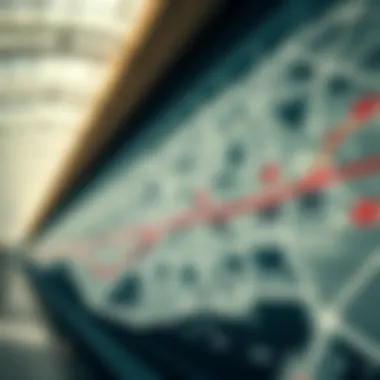
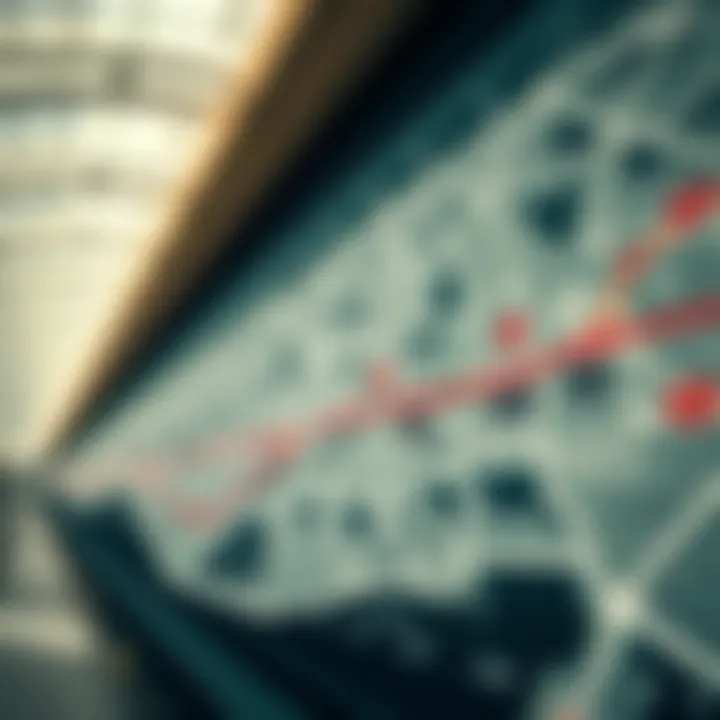
- Expansion of Residential Zones: New buildings have emerged, catering to both families and individuals looking for convenience. Locations such as Dubai Marina and Downtown Dubai have attracted high-rise developments that promise stunning views and proximity to transit.
- Suburban Migration: There's a trend of residents moving to suburban areas where housing might be more affordable while still relying on the Red Line to access the city's core. This shift influences where new developments spring up and highlights the need for sustainable planning to handle increased traffic.
This interplay between metro connectivity and population density exemplifies how urban growth can be strategically directed to accommodate new market demands.
Cultural Diversity and Urban Lifestyle
Dubai is famously a melting pot of cultures, which is significantly reflected in the demographics surrounding the Red Line. The city's unique blend of expatriates and locals creates a vibrant urban lifestyle that influences community interactions.
- Multicultural Vibes: Each station has its distinct character shaped by the different communities that inhabit the nearby spaces. For instance, areas such as Al Karama and Bur Dubai are known for their rich history and a colorful mix of South Asian, Middle Eastern, and Western cultures.
- Culinary Influences: The diverse cultures bring a wide range of culinary experiences, creating food havens in areas adjacent to metro stations. A stroll through these neighborhoods can feel like a journey across the globe— from Indian curry houses to Lebanese bakeries, there’s a taste for every palate.
The vibrancy stemming from this cultural diversity enriches the urban tapestry, showcasing how the metro not only facilitates transportation but also fosters a unique way of life that attracts more people, investors, and businesses into Dubai's landscape.
"The success of a transportation system is often measured by its ability to connect communities while respecting their cultural identities."
Investors and potential buyers should pay attention to these subtle yet impactful factors as they play a pivotal role in shaping property values and lifestyle prospects around the Red Line metro stations. Understanding the rich blend of cultures and the evolving population density trends can help in making well-informed decisions about real estate investments in Dubai.
For more insight into Dubai's urban development, visit Dubai Statistics Center.
For general knowledge about urban transport impacts, check Britannica.
Real Estate Impact
The relationship between metro stations along the Red Line and real estate is a dynamic one, reflecting broader trends in urban development, mobility, and economic growth. As the skyline of Dubai continues to evolve, the Red Line plays a crucial role in shaping these changes. It captures the interest of potential investors, homebuyers, and urban planners who are keen on understanding how proximity to these stations influences property values and overall lifestyle.
Metro stations function as catalysts for real estate development. They not only make commuting more convenient, but they can also enhance the attractiveness of nearby neighborhoods. Those looking to invest or buy often prioritize locations where convenient transport options are available. This demand tends to drive up property values, creating a positive feedback loop. As accessibility improves, more people move to these areas, and commercial opportunities arise alongside them. Thus, it’s essential to closely examine the trends in property values near these stations to assess their impact.
Property Value Trends Near Metro Stations
The effect of metro station proximity on property values cannot be overstated. Studies consistently show that properties situated within a short distance from metro stations typically experience higher property values compared to those located further away.
- Rising Values: Properties near Red Line stations have seen significant appreciation over the past years, driven primarily by the convenience offered by the metro system. Homes within a 500-meter radius often fetch prices 10-20% higher than their counterparts located further away.
- Investment Potential: Many investors are capitalizing on this trend by acquiring properties near metro stations. The potential for future appreciation remains high as the demand for housing in accessible areas continues to soar.
- Mixed-Use Developments: The introduction of mixed-use developments around stations adds another layer to property values. Such developments typically consist of residential units alongside commercial spaces, which attracts renters and buyers seeking a holistic living experience.
As a rule of thumb, areas surrounding metro stations tend to attract developments that fit the needs of an active lifestyle. With amenities like restaurants, gyms, and parks, residents increasingly value urban living that offers both convenience and leisure. This phenomenon paints a clear picture: being close to a metro station often elevates property desirability.
Attracting Investors and Buyers
The thriving environment of Dubai's urban landscape is ripe with opportunities, especially for investors and buyers eager to capitalize on metro station proximity. Here’s what draws them in:
- Attractive Yields: Properties located close to metro stations have shown robust rental yields, making them attractive for investors seeking steady returns. Many tenants prefer living near transport hubs, knowing they can navigate the bustling city efficiently.
- Growth Potential: For many investors, buying real estate near the Red Line is more than just a transaction—it's a strategic decision influenced by the long-term growth potential tied to Dubai’s expansion plans. The Red Line’s capacity to connect new developments with existing urban centers enhances its appeal as a lucrative investment.
- Expat Appeal: A significant portion of Dubai’s population comprises expatriates who often prioritize accessibility. This demographic seeks homes that minimize commute times, creating a healthy demand for properties bordering the Red Line.
- Market Resilience: Even in fluctuating market conditions, properties near metro stations maintain relative stability in value. Economic shifts may impact the overall real estate market, but areas with good transport links often bounce back quickly due to their sustained desirability.
"Proximity to public transport is a game changer for both property values and the lifestyle of residents."
Understanding these trends is essential for anyone looking to navigate the complex waters of Dubai’s real estate landscape. For further details on the urban planning initiatives in Dubai or to explore how to invest wisely, consider checking resources like Dubai Land Department or insightful articles on Wikipedia about the city's growth.
Business Opportunities
The Red Line metro system in Dubai is not just a means of transportation, but a catalyst for numerous business expectations and entrepreneurial ventures in the urban landscape. The relationship between metro stations and surrounding businesses is critical; as these stations continue to flourish, they create not just foot traffic, but also significant opportunities in various sectors. Understanding this dynamic enables potential investors and keen analysts to identify the golden nuggets of opportunity that lie in proximity to the metro network.
Commercial Developments Around Stations
Within the bustling atmosphere surrounding the Red Line stations, commercial developments are booming. Retail shops, restaurants, cafes, and service-oriented businesses are setting up shop. The presence of a metro station naturally elevates the footfall and attracts both local residents and visitors. This has led to a variety of commercial establishments springing up, such as:
- Retail Malls: Shopping centers like Mall of the Emirates and Dubai Mall have seen increased visibility due to their metro connectivity.
- Restaurants and Cafes: With a mix of global and local cuisines, there’s been an increase in eateries that cater to diverse tastes.
- Office Spaces: Co-working spaces and tech hubs are also making their mark, ideal for freelancers and startups.
Developers are keenly aware that the closer a commercial entity is to a metro station, the better its chances of success. It’s about accessibility and convenience; shoppers can hop on and off the metro without the hassle of parking, making these locations prime real estate for businesses.
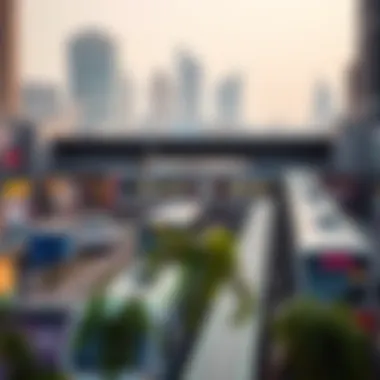
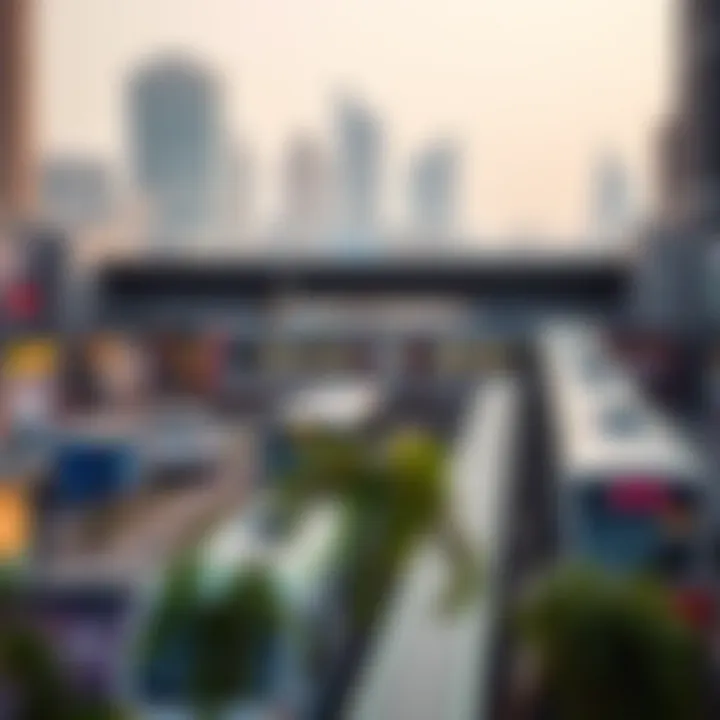
Job Growth Linked to Metro Expansion
The expansion of the Red Line has its fingers in various pies concerning job creation. As new stations are planned and opened, it’s expected that job opportunities will multiply both directly and indirectly. Here are several facets where job growth is noticeable:
- Construction Jobs: The building and developing of new metro stations create a significant number of jobs, both skilled and unskilled.
- Operational Staffing: Once stations open, there’s a need for staff to manage the operations—ticket collectors, maintenance crews, and customer service personnel are all essential roles that emerge.
- Service Sector Jobs: Businesses surrounding the stations hire to meet the service demands created by the influx of commuters.
As the Red Line grows, so does the potential for sustainable employment, allowing more residents to find work locally and reducing the need for lengthy commutes.
In summary, the Red Line serves as an economic powerhouse, driving growth not only in commercial real estate but also contributing significantly to job creation across various sectors. Understanding these nuances can equip investors and potential entrepreneurs with the insights they need to thrive in Dubai's vibrant market.
Future Developments and Projections
The dynamic nature of urban transportation in Dubai emphasizes the critical need for ongoing enhancements to the metro system. Future developments and projections for the Red Line are not just about extending tracks or adding stations; they encompass broader urban planning, environmental sustainability, and socio-economic growth. As Dubai’s urban landscape continues evolving, understanding these plans can help stakeholders—be it investors, urban analysts, or everyday commuters—make informed decisions.
Upcoming Stations and Extensions
Looking ahead, the addition of new stations is integral to enriching the connectivity offered by the Red Line. New stations are planned to cater to emerging neighborhoods and commercial hubs. For instance, the development of extensions towards Dubai’s southern regions, such as Dubai Expo 2020’s access, isn’t just a response to the immediate demand but aims to reduce traffic congestion over time.
Upcoming stations may include:
- Al Quoz: Positioned to serve the industrial and art district, this station would likely enhance access to cultural attractions, promoting tourism and local art initiatives.
- Dubai World Central: Intended to support the expansion of Dubai's aviation sector, it focuses on connecting key logistics and business areas, aligning with Dubai's vision as a global trade hub.
Each new station acts as a catalyst for potential growth in surrounding areas. As real estate developments rise nearby, property values are likely to reflect the increased accessibility and desirability of such locations. Therefore, investors should keep a keen eye on these developments.
Sustainability Initiatives in Metro Expansion
Sustainability is not just a trend; it’s a necessity in a rapidly developing world. Dubai’s metro expansion plans reflect a commitment to sustainability that recognizes the need for eco-friendly public transport. As the Red Line expands, initiatives to enhance its environmental footprint are vital.
Some sustainability initiatives include:
- Solar Energy Usage: There’s a concerted effort to incorporate solar panels in the station designs. This could provide renewable energy for station operations, significantly reducing carbon emissions.
- Green Certifications: Future stations aim to achieve green building certifications, such as LEED, which emphasizes energy efficiency and sustainable materials.
- Integrated Designs with Nature: Proposals for green roofs and vertical gardens around and within stations can enhance urban biodiversity while improving air quality.
Incorporating these features ensures that the metro not only provides a reliable form of transport but also enriches the urban environment, promoting healthier lifestyles among residents.
"The future of the Red Line is not merely in transport. It lies at the intersection of urbanism and sustainability, creating a model for urban transit networks worldwide."
As Dubai forges ahead with these advancements, the interaction between transport infrastructure and urban development will play a pivotal role in shaping the city’s landscape. Investors and urban planners alike must remain focused on these promising developments to leverage their advantages in a thriving market.
Culmination for Future Developments
The future development plans for the Red Line represent a synthesis of community needs, economic growth, and environmental responsibility. With strategic expansions and sustainable practices, these plans not only aim to improve transport efficiency but redefine how the metro system contributes to Dubai’s urban framework. For stakeholders, staying informed about these evolutions will be crucial in navigating the intricate landscape of Dubai’s property and transport sectors.
Finale
Navigating through the taran of the Red Line metro stations presents an array of insights and revelations. This article's exploration underscores the Red Line's vital role in shaping the urban landscape of Dubai. It highlights not only the practicality of efficient transport but also the broad spectrum of benefits this integral system brings to residents and investors alike.
In summation, the findings indicate a deep interconnection between metro accessibility and real estate trends, underlining the implications for ever-increasing property values in close proximity to stations. As the metro system continues to evolve, the blossoming business environment surrounding these hubs fortifies the economic vibrancy of the area.
"Metro stations are not merely stops, but gateways to growth and opportunity."
Summarizing Key Findings
From our comprehensive analysis, several key points emerge:
- Accessibility and Convenience: The Red Line has notably improved daily commuting for thousands, establishing a quicker and highly convenient transport solution.
- Real Estate Enhancement: Properties near metro stations are experiencing heightened demand and rising values, demonstrating a clear trend where transportation infrastructure influences investment decisions.
- Demographic Influence: The diverse communities surrounding the stations exemplify how urban living fosters cultural inclusivity, attracting varied demographics.
- Future-Proofing Urban Development: With upcoming expansions and sustainability initiatives, the Red Line sets a course for future growth, providing a framework for upcoming commercial ventures and residential projects.
The Role of the Red Line in Dubai’s Future
The evolution of the Red Line isn't just about transport; it's about the blueprint for Dubai's urban future. As the emirate positions itself as a global city, the Red Line stands at the crossroad of innovation and accessibility. Its further development is likely to:
- Catalyze Urban Growth: New stations and expansions mean more neighborhoods connected to vibrant commercial hubs, encouraging further investments.
- Strengthen Economic Activity: By facilitating easier movement throughout the city, the Red Line aids businesses in reaching customers efficiently, fostering economic resilience.
- Promote Sustainable Living: The emphasis on eco-friendly initiatives speaks to a growing awareness of sustainable urban practices. With such infrastructure in place, residents are encouraged to embrace a more environmentally-conscious lifestyle.



